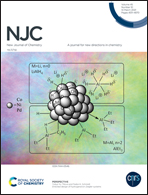Alcohol-soluble fluorene derivate functionalized with pyridyl groups as a high-performance cathode interfacial material in organic solar cells
Abstract
The synthesis and application as a cathode interfacial material (CIM) for organic solar cells (OSCs) of a fluorene-based conjugated small molecule (3FPy) with pyridyl functional side chains are presented. 3FPy is soluble in MeOH containing trace AcOH due to the interaction between pyridyl and AcOH, offering opportunities to fabricate multilayer OSCs by orthometric solution methods. When 3FPy was introduced into the conventional OSCs of both poly[4,8-bis(2-ethylhexyloxyl)benzo[1,2-b:4,5-b′]dithio-phene-2,6-diyl-altethylhexyl-3-fluorothithieno[3,4-b]thiophene-2-carboxylate-4,6-diyl] (PTB7):[6,6]-phenyl C71-butyric acid methyl ester (PC71BM) and poly[(4,8-bis(5-(2-ethylhexyl)thiophen-2-yl)benzo[1,2-b;4,5-b′]dithiophene-2,6-diyl-alt-(4-(2-ethylhexyl)-3-fluorothieno[3,4-b]thiophene)-2-carboxylate-2-6-diyl)] (PTB7-Th):PC71BM systems, significant simultaneous improvements in open-circuit voltage (Voc) and fill factor (FF) were achieved. It was found that pyridyl groups could lessen the cathode's work functions by interfacial dipoles, subsequently enlarging the built-in potentials and Voc. For the FF enhancements, the working mechanisms for 3FPy consisted of suppressing the devices’ dark currents, reducing the charge transport loss by n-doping PC71BM, and optimizing the contacts at the active layer/cathode interfaces. Therefore, this kind of novel small molecule is a promising CIM for high-performance OSCs.



 Please wait while we load your content...
Please wait while we load your content...